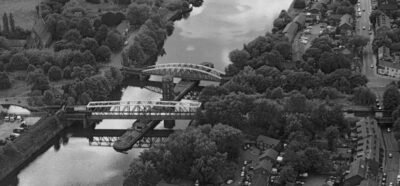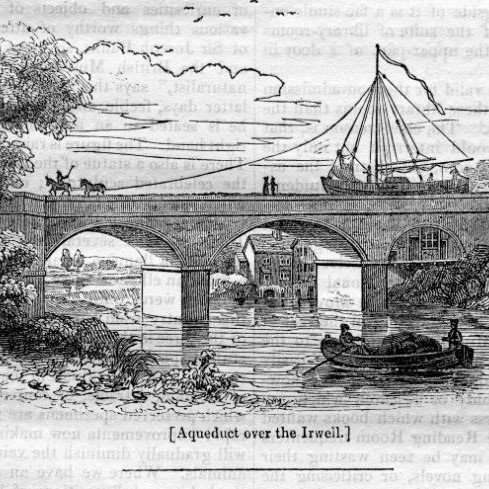From Castle to Wonder – The Tale of Two Aqueducts
Castle
In 1759 the 3rd Duke of Bridgewater, Francis Egerton, wanted to transport coal from his mines in Worsley to the rapidly expanding market in Manchester. The roads of the time were atrocious and a horse & cart could not carry very much so the Duke decided to build a canal. Along with his agent, John Gilbert, a scheme was devised to build a canal to the bank of the river Irwell in Salford and an Act of Parliament approved. The Duke and Gilbert then recruited millwright and water engineer James Brindley. This triumvirate soon decided they needed to cross the river Irwell and take the coal direct to the heart of Manchester.
For this development they needed an aqueduct to carry the proposed canal over the river Irwell, something unheard of previously. A location next to the existing road crossing at Barton was chosen. A second Act of Parliament was required to divert the canal but Parliament could not conceive of how this could work. Brindley made a model of the proposed aqueduct from a round of Cheshire Cheese to demonstrate the plan to Parliament. The Act was passed and the aqueduct was built within 3 years!

On 17th July 1761 the canal was opened from Worsley to Stretford and the first boat sailed over the stone aqueduct high above the river Irwell. It was described at the time as a ‘castle in the air’ and people came from far and wide to see this amazing engineering feat.
The price of coal in Manchester was halved overnight and the industrial revolution carried on apace. The Duke’s canal was then also extended to Runcorn where it met the river Mersey, providing a vital, reliable waterway between the two cities of Manchester and Liverpool, albeit on a circuitous ‘contour’ route.
Wonder
Manchester and Salford grew and then the railways came in 1830 so the expansion continued further. Eventually the business and civic interests in Manchester decided that there was a need for a more direct connection to the sea. The proposal was made for a ship canal following in general the courses of the rivers Mersey and Irwell. An Act of Parliament was passed in 1885 and work commenced on the Manchester Ship Canal.
One significant engineering challenge was how to carry the Bridgewater Canal over the new Ship Canal. The stone aqueduct, suitable until this time for the boats used on the River Irwell, would not allow passage of the size of ships expected to travel on the Ship Canal. Ship Canal chief engineer, Edward Leader Williams, came up with the solution – a swing aqueduct: a tank of water allowing boats to continue passing along the Bridgewater Canal but when a vessel needed to pass along the Ship Canal this tank could be sealed at either end and swung out of the way.

In 1894 the Manchester Ship Canal opened and over 125 years later the ‘unique’ Barton Swing Aqueduct is still the king of swing! Barton Swing Aqueduct is listed as one of the seven ‘Wonders of the Waterways.’
Today you can visit Barton Pocket Park to see the Swing Aqueduct and the remains of the Stone Aqueduct.
If you are interested in visiting the aqueducts and other places along the Bridgewater Canal in Salford contact:
Mark Charnley, Green Badge Tourist Guide for the Bridgewater Canal in Salford
Tel: 07884 121021








